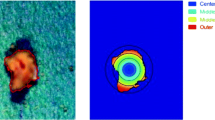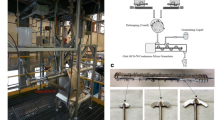Purpose
To investigate the effect of common pharmaceutical excipients on the kinetics of theophylline monohydrate formation during high-shear wet granulation.
Materials and methods
A mixture of anhydrous theophylline and the excipient was granulated in a high-shear granulator, using water as the granulation liquid. Non-contact Raman spectroscopy was used to monitor the rate of transformation of anhydrate to hydrate during the granulation process. The kinetics of conversion was also monitored in slurries of theophylline whereby the excipients were added to the aqueous phase. Optical microscopy was used to visualize the transformation and to measure the linear growth rates of hydrate crystals in the presence and absence of the excipients.
Results
At pharmaceutically relevant amounts of excipient, the transformation kinetics of theophylline was unchanged for the majority of excipients tested. However, when granulating with low concentrations of some commonly used polymeric binders, the transformation kinetics could be significantly retarded. For example, methylcellulose polymers delayed both the onset of hydrate formation as well as retarding the transformation rate. When 0.3% (w/w) of hydroxypropyl methylcellulose was added to a model formulation containing 30% (w/w) theophylline anhydrous, the formation of the monohydrate could be completely prevented over the time period of the granulation experiment, without significantly affecting the granular properties. Microscopic observations of hydrate formation in the presence of the polymer revealed that the polymers that inhibited hydrate formation reduced the hydrate crystal growth rates and influenced hydrate morphology.
Conclusions
Raman spectroscopy is a useful technique to monitor hydrate formation during wet granulation. Some commonly used polymeric pharmaceutical excipients can be used to manipulate theophylline hydrate formation in aqueous pharmaceutical environments. These excipients may affect either the nucleation and/or the growth of the hydrate phase.










Similar content being viewed by others
Abbreviations
- aW :
-
water activity
- EC:
-
Ethylcellulose
- HPC:
-
hydroxypropyl cellulose
- HPLC:
-
high-performance liquid chromatography
- HPMC:
-
hydroxypropyl methylcellulose
- HPMC-AS:
-
hydroxypropyl methylcellulose acetate succinate
- MC:
-
methylcellulose
- MCC:
-
microcrystalline cellulose
- MT:
-
theophylline monohydrate
- Na-CMC:
-
sodium carboxy methylcellulose
- NIST:
-
National Institute of Standards and Technology
- PAA:
-
cross-linked polyacrylic acid
- PVP:
-
polyvinyl pyrrolidone
- SDS:
-
sodium dodecyl sulfate
- SEM:
-
scanning electron microscopy
- SMT:
-
solvent-mediated transformation
- TP:
-
Theophylline
- USP:
-
United States Pharmacopeia
- UV:
-
ultraviolet
- XRPD:
-
powder X-ray diffractometry
References
L. L. Augsburger, and M. K. Vuppala. Theory of granulation. In D. M. Parikh (ed.), Handbook of Pharmaceutical Granulation Technology, Vol. 81, Marcel Dekker, New York, NY, 1997, pp. 7–23.
P. Holm. High shear mixer granulators. In D. M. Parikh (ed.), Handbook of Pharmaceutical Granulation Technology, Vol. 81, Marcel Dekker, New York, NY, USA, 1997, pp. 151–203.
S. R. Byrn. Solid State Chemistry of Drugs, Academic, New York, NY, USA, 1982.
K. R. Morris, U. J. Griesser, C. J. Eckhardt, and J. G. Stowell. Theoretical approaches to physical transformations of active pharmaceutical ingredients during manufacturing processes. Adv. Drug Deliv. Rev. 48:91–114 (2001).
H. G. Brittain. Methods for the characterization of polymorphs and solvates. In H. G. Brittain (ed.), Polymorphism in Pharmaceutical Solids, Vol. 95, Marcel Dekker, New York, NY, 1999, pp. 227–278.
Y. Qiu, X. Z. Qu, X. Q. Song, J. X. Chen, and F. T. Chau. Construction of a CCD multichannel fiber-optic spectrometer and its application. Instrum. Sci. Technol. 24:143–150 (1996).
H. Wikström, P. J. Marsac, and L. S. Taylor. In-line monitoring of hydrate formation during wet granulation using Raman spectroscopy. J. Pharm. Sci. 94:209–219 (2005).
E. Räsänen, J. Rantanen, A. Jørgensen, M. Karjalainen, T. Paakkari, and J. Yliruusi. Novel identification of pseudopolymorphic changes of theophylline during wet granulation using near infrared spectroscopy. J. Pharm. Sci. 90:389–396 (2001).
N. Rodríguez-Hornedo, and H. J. Wu. Crystal-growth kinetics of theophylline monohydrate. Pharm. Res. 8:643–648 (1991).
Specifications: Test procedures and acceptance critera for new drug substances and new drug products: Chemical substances Q6A, ICH Steering Committee, International Conference on Harmonization, Geneva, Switzerland, 1999, p. 31.
I. Katzhendler, R. Azoury, and M. Friedman. Crystalline properties of carbamazepine in sustained release hydrophilic matrix tablets based on hydroxypropyl methylcellulose. J. Control Release. 54:69–85 (1998).
I. Katzhendler, K. Mader, R. Azoury, and M. Friedman. Investigating the structure and properties of hydrated hydroxypropyl methylcellulose and egg albumin matrices containing carbamazepine: EPR and NMR study. Pharm. Res. 17:1299–1308 (2000).
I. Katzhendler, R. Azoury, and M. Friedman. The effect of egg albumin on the crystalline properties of carbamazepine in sustained release hydrophilic matrix tablets and in aqueous solutions. J. Control Release. 65:331–343 (2000).
M. Otsuka, T. Ohfusa, and Y. Matsuda. Effect of binders on polymorphic transformation kinetics of carbamazepine in aqueous solution. Colloid. Surf. B-Biointerfaces. 17:145–152 (2000).
N. Rodríguez-Hornedo, and D. Murphy. Surfactant-facilitated crystallization of dihydrate carbamazepine during dissolution of anhydrous polymorph. J. Pharm. Sci. 93:449–460 (2004).
F. Tian, D. J. Saville, K. C. Gordon, C. J. Strachan, J. A. Zeitler, N. Sandler, and T. Rades. The influence of various excipients on the conversion kinetics of carbamazepine polymorphs in aqueous suspension. J. Pharm. Pharmacol. 59:193–201 (2007).
H. Qu, M. Louhi-Kultanen, and J. Kallas. Additive effects on the solvent-mediated anhydrate/hydrate phase transformation in a mixed solvent. Cryst. Growth Design. 7:724–729 (2007).
S. Airaksinen, P. Luukkonen, A. C. Jørgensen, M. Karjalainen, J. Rantanen, and J. Yliruusi. Effects of excipients on hydrate formation in wet masses containing theophylline. J. Pharm. Sci. 92:516–528 (2003).
S. Airaksinen, M. Karjalainen, N. Kivikero, S. Westermarck, A. Shevchenko, J. Rantanen, and J. Yliruusi. Excipient selection can significantly affect solid-state phase transformation in formulation during wet granulation. AAPS PharmSciTech. 6: (2005).
Theophylline capsules. USP28-NF23, Vol. S2, United States Pharmacopeia, Rockville, MD, USA, 2005.
J. Rantanen, H. Wikström, F. E. Rhea, and L. S. Taylor. Improved understanding of factors contributing to quantification of anhydrate/hydrate powder mixtures. Appl. Spectrosc. 59:942–951 (2005).
D. J. W. Grant, and T. Higuchi. Solubility Behavior of Organic Compounds, Wiley, New York, NY, USA, 1990.
M. D. Ticehurst, R. A. Storey, and C. Watt. Application of slurry bridging experiments at controlled water activities to predict the solid-state conversion between anhydrous and hydrated forms using theophylline as a model drug. Int. J. Pharm. 247:1–10 (2002).
P. T. Cardew, and R. J. Davey. The kinetics of solvent-mediated phase-transformations. Proc. R Soc. Lond. A. 398:415–428 (1985).
A. A. Noyes, and W. R. Whitney. The rate of solution of solid substances in their own solutions. J. Am. Chem. Soc. 19:930–934 (1897).
A. W. Hixson, and J. H. Crowell. Dependence of reaction velocity upon surface and agitation I—Theoretical consideration. Industrial Eng. Chem. 23:923–931 (1931).
J. W. Gibbs. On the equilibrium of heterogeneous substances. Trans. Conn. Acad. 3:343–524 (1878).
J. W. Mullin. Crystallization, Elsevier, Oxford, UK, 2001.
T. P. Melia, and W. P. Moffitt. Secondary nucleation from aqueous solution. Industrial Eng. Chem. 3:313–317 (1964).
W. K. Burton, N. Cabrera, and F. C. Frank. The growth of crystals and the equilibrium structures of their surfaces. Philosophical Transactions of the Royal Society of London Series A, Mathematical and Physical Sciences. 243:299–358 (1951).
N. Rodríguez-Hornedo, D. Lechuga-Ballesteros, and H. J. Wu. Phase-transition and heterogeneous epitaxial nucleation of hydrated and anhydrous theophylline crystals. Int. J. Pharm. 85:149–162 (1992).
B. C. Hancock, P. York, and R. C. Rowe. The use of solubility parameters in pharmaceutical dosage form design. Int. J. Pharm. 148:1–21 (1997).
Acknowledgements
Dr. Alan Gift, Daniel Sage and Margaret K. Kunkel (all Purdue University) are gratefully acknowledged for assistant with data analysis and experimental support. Jerry J. Sheppard (Purdue University) is acknowledged for his assistance with designing the small-scale granulator, and the general machine shop of Purdue University is thanked for building it. The authors are grateful to Mary A. Albrecht (SSCI, Inc.) for providing the SEM pictures. Sharon Deram (SBI Analytical, Inc.) and Kaiser Optical Systems, Inc., are acknowledged for their assistance with instrumentation. The Dow Chemical Company, BASF and ISP Technologies, Inc. are thanked for supplying the majority of the polymers used for this study. The Dane O. Kildsig Center for Pharmaceutical Processing Research and AstraZeneca R&D Mölndal are acknowledged for funding.
Author information
Authors and Affiliations
Corresponding author
Rights and permissions
About this article
Cite this article
Wikström, H., Carroll, W.J. & Taylor, L.S. Manipulating Theophylline Monohydrate Formation During High-Shear Wet Granulation Through Improved Understanding of the Role of Pharmaceutical Excipients. Pharm Res 25, 923–935 (2008). https://doi.org/10.1007/s11095-007-9450-x
Received:
Accepted:
Published:
Issue Date:
DOI: https://doi.org/10.1007/s11095-007-9450-x




